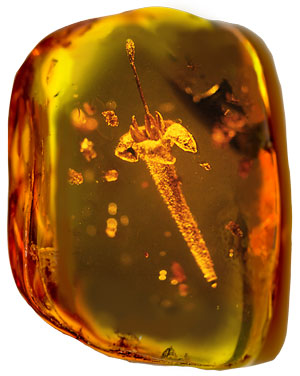Deadly plant’s flowers in amber deadly to evolution
 © George Poinar, Jr.
© George Poinar, Jr.The discovery of two “remarkably complete” flowers beautifully preserved in amber has excited experts.1 The amber (fossilized tree resin) from an amber mine in the Dominican Republic is said by evolutionists to be 15–45 million years old. Professor George Poinar (Oregon State University, USA), an entomologist who has spent almost 30 years researching the wealth of insects entombed in amber fossils, noticed flowers that might belong to Strychnos. Shrubs and trees in this genus, named by creationist Carl Linnaeus in 1753, contain the highly toxic alkaloid strychnine, often used in rat poisons.
“These flowers looked like they had just fallen from a tree,” said Professor Poinar.2 He sent high resolution photos to Lena Struwe, Professor of Botany, Rutgers University, USA, an expert on Strychnos. After comparing them with museum collections of some 200 known species, she decided it was a new species, Strychnos electri (in Greek, amber is ἤλεκτρον, ēlektron). Their joint paper was recently published in Nature Plants.3
Professor Struwe believes they have “particular significance for our understanding of the evolution of plants in the Caribbean and the New World tropics.” However, the grounds for announcing a new species were such minute factors as the precise location and appearance of hairs on the petals—so her claim is overstated. Biblically, the many different species of this genus of flowering plants all likely descended from one created plant kind. Organisms were designed with the capacity to vary, but within limits. The observed diversity across Strychnos species is not evidence for the evolution of one kind of plant from another; rather it fits perfectly with creation biology.
Additionally, what has been overlooked here is how the flowers could be in such good condition after the claimed 15 million (at least) years—so good in fact, that they could be identified not just as the genus Strychnos, as if fresh off the tree (!), but in such minute petal-hair detail as to allow meticulous microscopic comparisons at species level.
The bigger picture
When these amber fossils (pictured) are considered in tandem with the many others in the scientific literature showing equally exquisite preservation, a ‘big picture’ emerges that is absolutely ‘deadly’ to evolutionary chronology and long-age ideas of amber fossil formation.
For example, amber ‘dated’ at 320 million years has been found to have a molecular composition seen only in flowering plants (angiosperms). Yet these supposedly did not arise until 200 million years later!4 And the organisms entombed in amber overwhelmingly show ‘evolutionary stasis’5—they are the same as their counterparts today.
What’s more, the vast extent of many amber deposits, and the types of organisms entombed, point to a preservation event way beyond the resin-oozing-slowly-from-forest-trees scenario mooted by evolutionists. While insects predominate, lizards6 and aquatic (even marine) creatures7 have also been found in amber—as well as mammal hair8 and, just recently, bird wings.9 It all points to a catastrophic event of biblical proportions, with resin bleeding profusely from forestloads of smashed floating logs: the Flood of Noah’s day, only around 4,500 years ago.10
References and notes
- Extinct plant species discovered in amber, bbc.co.uk, 15 February 2016.
- Branson, K., Trapped in Amber: Rutgers Botanist Names New Flower Species—Strychnos electri makes its debut after being preserved in fossilized resin for at least 15 million years, news.rutgers.edu, February 2016.
- Poinar, G. and Struwe, L., An asteroid flower from neotropical mid-Tertiary amber, Nature Plants 2:16005, February 2016 | doi:10.1038/nplants.2016.5.
- Oard, M.J., 320-million-year-old amber has flowering plant chemistry, J. Creation 24(2):16, 2010; creation.com/floral-amber.
- Bell, P., Evolutionary stasis: double-speak and propaganda, Creation 28(2):38-40, 2006; creation.com/stasis.
- See creation.com/focus-381#lizards.
- Oard, M.J., Marine fossils in amber suggest the Flood log-mat model, J. Creation 24(1):9–10, 2010.
- See creation.com/amber-hair.
- Xing, L. and 12 others, Mummified precocial bird wings in mid-Cretaceous Burmese amber, Nature Communications 7:12089, 28 June 2016 | doi:10.1038/ncomms12089.
- Catchpoole, D., Amber needed water (and lots of it), Creation 31(2):20–22, 2009; creation.com/amber1.







Readers’ comments
Comments are automatically closed 14 days after publication.